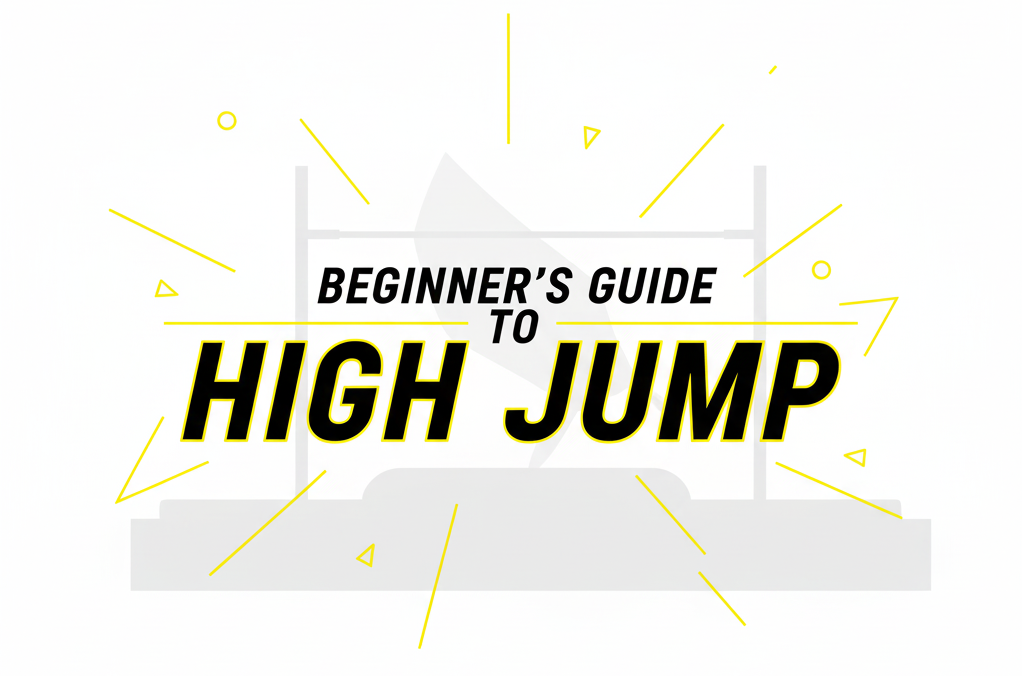Beginner’s Guide to High Jump:
The high jump is a captivating track and field event that combines strength, agility, and precise technique. For newcomers, understanding the fundamental aspects—from the official rules to the essential equipment—is paramount for a safe and successful start. This comprehensive beginner’s guide is designed to demystify the high jump, providing you with a solid foundation in its rules, how scoring works, and what gear you’ll need. Whether you’re an aspiring athlete or simply curious, get ready to elevate your understanding and take your first leap into the exciting world of high jump.
1. High Jump 101: Understanding the Basics for Beginners
At its core, the high jump is an athletic discipline where competitors attempt to clear a horizontal bar placed at increasing heights without knocking it off its supports. Athletes typically employ a run-up, transition into a powerful takeoff, and then use a specific technique, most commonly the Fosbury Flop, to propel themselves over the bar and land safely on a thick mat. The goal is simple: clear the highest bar possible. This event demands not only physical prowess but also a keen understanding of body control and timing.
Beginner’s Guide to High Jump: Key Points
– Objective: To clear a horizontal bar at the highest possible height without displacing it.
– Technique: Most modern high jumpers use the ‘Fosbury Flop’ where they go over the bar backward.
– Setup: The event requires a resilient landing pit, two upright standards, and a lightweight crossbar.
Beginner’s Guide to High Jump: Practical Insights
– Focus on body awareness: Practice basic jumping and landing drills to get comfortable with airtime.
– Start low: Begin with very low bar heights to build confidence and refine your technique before attempting higher jumps.

2. The Official High Jump Rules: Your Essential Guide to Competition
Understanding the official high jump rules is crucial for any aspiring competitor. Athletes are given three attempts at each height. If an athlete fails to clear the bar on all three attempts at a given height, they are eliminated from the competition. A jump is considered a ‘failure’ if the athlete knocks the bar off its supports, passes under the bar, or takes off from two feet (only one foot is permitted for takeoff). Additionally, touching the ground beyond the plane of the bar or landing pit before clearing the bar can also result in a foul. Mastering the mechanics of your run-up and takeoff is crucial, and incorporating specific training can significantly improve your technique and help avoid fouls.
Key Points
– Attempts per height: Athletes receive three attempts to clear each height.
– Takeoff rule: Only one foot is allowed to make contact with the ground at takeoff.
– Foul conditions: Knocking the bar off, taking off with two feet, or passing under the bar results in a foul.
Practical Insights
– Practice consistent run-up: Develop a repeatable approach to the bar to optimize your takeoff.
– Familiarize yourself with specific foul rules: Knowing what constitutes a foul can help you avoid common mistakes during competition.
3. Decoding High Jump Scoring: How Athletes Win & Records are Set
High jump scoring is straightforward: the athlete who successfully clears the greatest height wins. If multiple athletes clear the same maximum height, tie-breaking rules come into play. The primary tie-breaker is the fewest number of failures at the final height cleared. If still tied, the total number of failures throughout the entire competition is considered. If a tie persists, a jump-off may be used, where athletes compete at progressively lower or higher heights until a clear winner emerges. This system rewards not just peak performance, but also consistency and strategic attempt management.
Key Points
– Winning criteria: The athlete clearing the highest bar wins.
– Primary tie-breaker: Fewest failures at the final height cleared.
– Secondary tie-breaker: Fewest total failures throughout the competition.
Practical Insights
– Strategic attempts: Learn when to ‘pass’ on a height to save attempts for higher bars, especially in multi-day events.
– Consistency is key: Aim for clean clearances to minimize failures and improve your standing in tie-breaking scenarios.
5. The High Jump Setup: Pit, Standards & Bar Explained
The high jump area is meticulously set up to ensure both fairness and safety. The primary component is the landing pit, a large, thick foam mat designed to absorb the impact of an athlete’s landing. This pit is typically at least 6 meters long and 4 meters wide. Flanking the pit are two upright standards, which hold the crossbar at various heights. These standards have adjustable mechanisms to raise or lower the bar. The crossbar itself is a lightweight, usually fiberglass or aluminum, bar that is easily dislodged if touched, indicating a failed attempt. Understanding this setup helps athletes visualize their jump and coaches ensure proper safety protocols are met.
Key Points
– Landing Pit: A large, soft foam mat vital for safe landings, typically 6m x 4m.
– Standards: Upright posts with adjustable mechanisms to hold the crossbar at different heights.
– Crossbar: A lightweight, easily dislodgeable bar that defines the height to be cleared.
Practical Insights
– Inspect the setup: Always check the pit for proper cushioning and the standards for stability before jumping.
– Understand bar placement: Familiarize yourself with how the bar height is measured and adjusted to avoid confusion during competition.
4. Essential High Jump Equipment: What You Need to Get Started Safely
While the high jump doesn’t require an extensive list of personal equipment, a few key items are essential for both performance and safety. Proper athletic wear that allows for a full range of motion is important. The most critical piece of equipment for an athlete is their footwear. For serious aspiring high jumpers, investing in specialized high jump spikes can make a significant difference in performance and safety, providing the necessary grip and support for explosive takeoffs. These specialized shoes feature a flat sole with spikes typically at the heel and forefoot, optimized for the unique demands of the high jump approach and takeoff.
Key Points
– Footwear: Specialized high jump spikes are highly recommended for optimal grip and support.
– Clothing: Comfortable, athletic attire that does not restrict movement.
– Safety: Always ensure a thick, compliant landing pit is in place.
Practical Insights
– Invest wisely: Consider high-quality high jump spikes as they directly impact your takeoff power and stability.
– Dress for success: Choose breathable, flexible athletic wear that won’t hinder your run-up or arch over the bar.
6. Common Challenges for Beginner High Jumpers & Quick Fixes
Beginners often face a few universal hurdles in their high jump journey. One common issue is an inconsistent approach, leading to mistimed takeoffs. Fear of the bar, particularly when attempting higher jumps, can also cause hesitation and a breakdown in technique. Another frequent challenge is improper body positioning over the bar, where athletes might not achieve the necessary arch or hip lift. Many common challenges can be addressed with focused drills; for instance, improving your approach consistency can be enhanced by specific drills. Breaking down the jump into smaller, manageable parts—approach, takeoff, bar clearance, and landing—and practicing each segment individually can help address these issues systematically.
Key Points
– Inconsistent approach: Difficulty in maintaining a consistent run-up rhythm and speed.
– Fear of the bar: Hesitation or ‘bailing out’ at the last moment due to fear of hitting the bar.
– Poor body position: Inadequate arch or hip drive over the bar, leading to premature contact.
Practical Insights
– Drill consistency: Practice your run-up repeatedly without the bar to build muscle memory and rhythm.
– Visualization: Mentally rehearse successful clearances to overcome bar fear and build confidence.
– Segment practice: Work on individual phases of the jump (e.g., approach, takeoff, arch) before combining them.
7. Your First Steps: How to Start Your High Jump Journey Successfully
Embarking on your high jump journey can be incredibly rewarding. The most crucial first step is to seek guidance from an experienced coach or join a local track and field club. Proper instruction will ensure you learn correct technique from the outset, minimizing the risk of injury and accelerating your progress. Start by mastering the fundamental movements, focusing on coordination, strength, and flexibility before chasing height. Consistent practice, coupled with patience and a positive attitude, will be your greatest assets. Remember, every elite high jumper started as a beginner, so embrace the learning process and celebrate every small improvement.
Key Points
– Seek expert coaching: Professional guidance is invaluable for learning proper technique and ensuring safety.
– Master the fundamentals: Focus on basic coordination, strength, and flexibility exercises before advanced jumps.
– Practice consistently: Regular, deliberate practice is essential for skill development and improvement.
– Set realistic goals: Celebrate small victories and understand that progress takes time and effort.
Practical Insights
– Join a club or team: Being part of a high jump community provides support, resources, and competitive opportunities.
– Film your jumps: Reviewing footage can help you identify areas for improvement and track your progress effectively.

